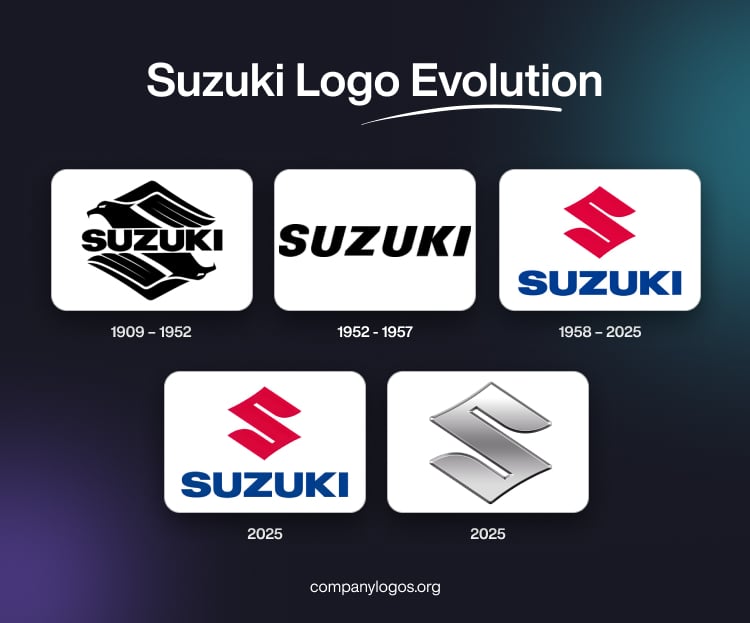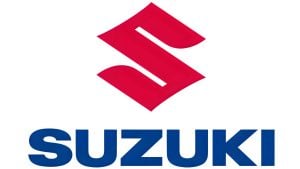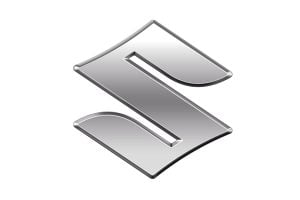
Suzuki is a world-renowned Japanese motor company that specialises in the manufacture of a wide range of vehicles. These include motorcycles, cars, ATVs, and more. Founded in 1909 by Michio Suzuki, the company operates in about 192 countries. The Suzuki logo is a distinctive emblem that has evolved alongside the company. Its history illustrates the design trends of the day as well as the shifting corporate ambitions and cultural values. The article delves into the evolution of the Suzuki logo, among other details of the company.
The Genesis of the Suzuki Logo (1909 – 1952)
The original logo featured a mirrored image of a stylised bird creating an “S” shape to symbolise grace and the company’s initials. This classy black and white logo had the brand name written in a modern geometric sans-serif typeface in uppercase. It was placed at the centre of a graphical emblem depicting the shape of the letter “S” as two mirror images of a bird with sharp wings.

(1952 – 1957)
The 1952 logo did away with the bird emblem and featured only the logotype “Suzuki” in italicised uppercase letters and rendered using a sans-serif typeface in black.

(1958 – 2025)
In 1958, as Suzuki shifted focus more heavily toward the automotive and motorcycle industries, it unveiled the logo that would become synonymous with the brand. It was a bold, angular, stylised “S” in red. It showcased thick geometric lines conveying power and clarity, with the company name “Suzuki” in uppercase set in a Helvetica-like font appearing below the emblem. The emblem and the wordmark were designed in a red and blue colour palette. In this scheme, the red “S” stood for passion and integrity, while the blue wordmark signified class and brilliance.

(2025)
In April 2025, Suzuki unveiled its first significant logo update in almost 40 years. The new iteration retains the essential shape of the stylised “S” but introduces thicker lines, a deeper red for the “S,” and a darker, bolder blue for the wordmark. It uses a more modern high-contrast font for improved legibility on digital platforms and vehicle displays.

(2025)
Suzuki boasts two types of logos: a red and blue corporate logo for the website and other marketing materials, and another chrome-plated 3D logo to be used as a badge on cars and motorcycles. Of late, the carmaker has come out with a new badge that carries a flat design with a matte silver finish. However, the familiar “S” shape has been retained, but with a smoother edge and simpler surface.
The switch from glossy chrome plating to a high-brightness silver resembling matte aluminium is aimed at reducing environmental impact – chrome plating involves more resource- and chemical-intensive processes. The new 2D flat design logo is expected to work better on screens and align with the current design trends in the auto industry. Upon making its global debut in October, the new badge can easily be fitted to grilles of current models. In the Indian context, the new Suzuki logo is likely to feature on the Maruti Suzuki Victoris SUV and a host of other models, such as the Ertiga, Grand Vitara, and Fronx.

The Elements of the Suzuki Logo
Symbol
The Suzuki logo features a stylish letter “S” with sharp angles. The curved and pointed lines of the letter “S” were similar to the glyphs and Samurai traditions.
Font
The wordmark that forms part of the Suzuki logo is rendered in a Neue Helvetica Pro 93 Extended Black typeface. The font was developed by Max Miedinger along with Edward Hoffmann.
Colour
The Suzuki logo comes in two colours—black and white and a combination of red, blue, and white. Here, the colours black and white symbolise professionalism, sophistication, and strength. On the other hand, red symbolises passion and life, while blue symbolises trust and reliability.
The History of Suzuki
Suzuki was established in 1909 in Hamamatsu, Shizuoka Prefecture, Japan, by Michio Suzuki. The company initially specialised in producing innovative weaving looms for the thriving Japanese silk industry. Michio Suzuki’s inventions, such as a new type of loom, quickly found success and demand both domestically and internationally. The success in loom production lasted for nearly three decades, which made Suzuki a well-respected name in industrial Japan.
After realising the need to broaden the business, Suzuki went for diversification in the late 1930s. In 1937, the company began developing small passenger cars. By 1939, Suzuki had produced several innovative compact prototypes, which were powered by a then-modern four-cylinder engine. However, in spite of promising advancements, further automobile production was halted due to the Second World War and government restrictions on civilian vehicles. After the war, Suzuki temporarily returned to loom manufacturing until the collapse of the cotton market in 1951.
Responding to the urgent need in Japan for personal transportation, Suzuki entered the powered bicycle and motorcycle space in 1952. Thereupon, it produced the “Power Free” 36cc motorised bicycle. The success of this model and further innovations led to the creation of the “Diamond Free” and “Colleda” motorcycles. By 1954, the company officially changed its name to Suzuki Motor Co., Ltd.
In 1955, Suzuki launched its first production car, the “Suzulight,” a compact, lightweight model with front-wheel drive and independent suspension. This vehicle helped create the segment of small and affordable cars. It set a new standard in the Japanese market for years to come.
Throughout the 1960s and 1970s, Suzuki expanded its product range and global footprint. For example, it opened its first overseas assembly plant in Thailand in 1967 and entered the light truck market with the Suzulight Carry. In 1970, it debuted the now-iconic Suzuki Jimny, which was one of the earliest compact 4×4 vehicles.
Suzuki broadened into marine engines and outboard motors and developed all-terrain vehicles. By the late 1980s and early 1990s, collaborations, such as the partnership with General Motors, accelerated Suzuki’s presence in Western markets and emerging economies. In 1990, after recognising its global reach, Suzuki adopted its current name, Suzuki Motor Corporation.
An important chapter began in the 1980s with the formation of Maruti Udyog Limited, a joint venture with the Government of India. The launch of the Maruti 800 in 1983 revolutionised the Indian car market and made it accessible to millions. Over decades, Maruti Suzuki has dominated India’s automobile market and has become a pillar of Suzuki’s global strategy.
Suzuki has continued to innovate with new vehicle models and technology. For instance, it pioneered compact car technology, including hybrid and fuel-efficient engines. It also expanded production and sales across Asia, Europe, Africa, and Latin America and has remained a leader in motorcycles, automobiles, and marine engines.
Suzuki has grown from a local loom manufacturer to a global force in automobiles and motorcycles. It is characterised by adaptability, engineering innovation, and leadership in the compact and affordable vehicle space. It continues to be recognised for its durability, everyday value, and global reach. Besides, it upholds Michio Suzuki’s founding philosophy of making life better for people through practical technology.
Interesting Facts About Suzuki
- Suzuki started as Suzuki Loom Works in Hamamatsu, Japan, by Michio Suzuki. It used to manufacture weaving looms for Japan’s silk industry.
- Suzuki launched its first car, the Suzulight, in 1955, which was one of Japan’s earliest Kei cars (small vehicles designed for urban use).
- Suzuki operates in over 190 countries and has manufacturing plants in countries including India, Indonesia, Thailand, Pakistan, Hungary, and Egypt.
- Suzuki is considered one of Japan’s “Big Four” motorcycle makers, along with Yamaha, Honda, and Kawasaki.
- The Suzuki Hayabusa, introduced in 1999, was the fastest production motorcycle in the world. It can reach speeds of nearly 312 km/h (194 mph).
- Suzuki has won multiple world championships in MotoGP and other motorcycle racing events since the 1960s.
- Its Indian subsidiary, Maruti Suzuki, is the largest car manufacturer in India and accounts for over 40% of the Indian passenger car market.
- Suzuki entered India in 1982 through a joint venture with the Indian government-owned company Maruti Udyog Limited.
- The Maruti Suzuki Alto is one of the best-selling cars in the world, with millions sold in India alone.
- Suzuki has long been a leader in compact and lightweight vehicles, especially in the Kei car segment in Japan.
- Suzuki developed the AllGrip four-wheel drive system, which improved performance and safety in SUVs and crossovers like the Vitara and S-Cross.
- Suzuki’s philosophy of “smaller, fewer, lighter, shorter, and neater” aligns with its push for fuel efficiency and eco-friendly vehicles.
- Suzuki is actively investing in electric and hybrid technology, especially in partnership with Toyota. It plans to launch electric vehicles in India and globally.
- Suzuki’s Jimny has gained cult status as a rugged, tiny off-roader loved worldwide for its agility and durability.
- Beyond cars and motorcycles, Suzuki is a leading maker of marine outboard motors, which are widely used in boats and watercraft.
- Suzuki exited the U.S. passenger car market in 2012, though it still sells motorcycles and ATVs there.
Finally
Suzuki’s logo evolution is a testament to the power of thoughtful continuity and strategic modernisation. The logo unites the deep-rooted heritage of the company with a forward-thinking vision that helps customers to easily identify the brand.